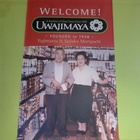It is not clear why Fujimatsu Moriguchi, who founded Uwajimaya, went to America in the first place, or what the trigger was. However, it is likely that it was related to the environment in the southwestern part of Ehime Prefecture where he was born, raised, and trained.
In the area around Kawakami Village, Nishiuwa County, where Fujimatsu was born (present-day Yawatahama City), there was a growing enthusiasm for immigration and travel to America from the Meiji period, and many men made the journey to America, sometimes at the risk of their lives. One time, they attempted to cross the Pacific Ocean on a sailing ship called a Utase-bune, which was used for fishing.
The historical fact of the stowaway practice of that time, in which a magnet in a wooden frame was attached to the side of a sailing ship as a compass, known as the "Kitahari," was depicted in a non-fiction book titled "Kitahari" written by Ono Kaoru in the 1980s. In addition, as these facts were unearthed, the "Kitahari Research Society" (later known as the "Regional Culture Promotion Council Kitahari") was formed by local people in the former Mana village (now the Mana district of Yawatayama City), where crossings were particularly popular.
A land of enterprising spirit
Yuki Matsuura, who has been listening to the stories of the elders at this research group, summarized the trends of local immigrants and published them in the newspaper 10 years ago (April 23, 2008, Nihon Keizai Shimbun). According to this, between 1912 and 1915, six Utase-bune boats made it across the Pacific Ocean from the area around Yawatahama City.
The first were five people from Kawanoishi, the former town of Honai, who were forcibly repatriated, but as far as we know, this was the first time that Japanese people crossed the Pacific Ocean on a private sailing ship. Of course, there were failures, some people died from poisoning after eating fish they had caught at sea, and one case was that they drifted to the coast of Alaska and were rescued by the Inuit.
What motivated people to take such risks and travel to America? It is generally thought that immigrants of this time came out of poverty and economic reasons, but in this region, it seems that they had dreams and ambitions, even if they weren't looking to get rich overnight.
Matsuura writes, "In Mana, wealthy local leaders such as fishermen and village headmen were pioneers. As is the nature of the local area, they were highly enterprising and sensitive to information from elsewhere. Perhaps this is why they were able to forge ahead through the rough seas with big dreams."
Nishii Kyuhachi, who increased immigration enthusiasm in the local area
When talking about "enterprising spirit" in Yawatahama, one of the first names to come up is Ninomiya Chuhachi, also known as the "father of Japanese aviation." Born in 1866, Ninomiya learned to play with homemade kites as a child, and one day after joining the military, he saw a crow gliding and grasped the principles of flight, creating a "crow-shaped model aircraft," and continued to aim to create practical aircraft. Unfortunately, he was surpassed by the Wright brothers in terms of the success of manned airplanes, but a bronze statue of Ninomiya Chuhachi stands locally in recognition of his achievements in coming up with the principles of flight at an early stage and his passion for making it a reality.
Chuhachi had no experience of emigrating to America, but there was another local hero, Nishii Kyuhachi, who succeeded as an immigrant in America and has a bronze statue in Yawatahama as well. Unfortunately, when I visited Shikokuyama, where the statue is located, last year, it was buried under the grass and trees, so it seems that he has been forgotten. However, it seems that many people were inspired by Nishii's success story, who became a businessman in Seattle and Tacoma, and went to America.
Nishii was born ten years before Ninomiya in 1856 as the second son of a farmer and fisherman in Yanozaki Village, Nishiuwa County. He worked as a crew member on a foreign ship, first working at a lumber mill in Portland, Oregon, then moving to Seattle where he opened the first Japanese restaurant. His restaurant, which was also popular with white people, employed people who came to him from his hometown and supported his friends who were also trying to open restaurants.
Nishii opened many Western-style restaurants, and also ran a variety of successful businesses, including farm management, dry cleaning, hotels, and gold mining. He also donated funds to help build an elementary school in his hometown, and was loved and respected in Seattle and Tacoma as well as in his hometown.
It is not difficult to imagine that many people were attracted to the success stories of Nishii and others in America and decided to cross the ocean again. Fujimatsu Moriguchi was probably one of them.
(Titles omitted)
© 2018 Ryusuke Kawai







